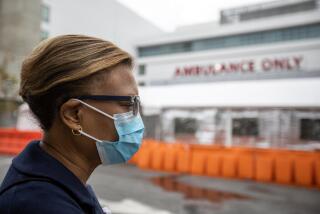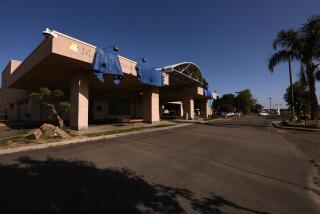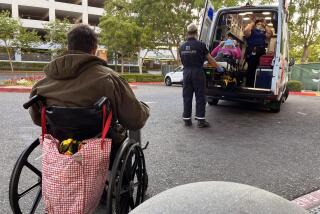Sharp Reflects Financial Bind Facing Many U.S. Hospitals
Once upon a time, there was a wondrous hospital with magic machines and doctors who ordered tests as many times as they felt they were needed. An extra day spent in the hospital, âjust to make sure youâre OK,â was a matter of course.
It was a place where patients got well while the hospital made more than enough money to cover its expenses. That was the way it was supposed to work. But, all across the nation, the grim reality is something far different as hospital after hospital faces the threat of financial ruin.
An example of that reality hit home in San Diego this month as Sharp Memorial Hospital laid off 44 of its 2,200 employees, an indication of tougher times ahead for its parent organization, Sharp HealthCare , a nonprofit corporation. The corporation is one of the largest health care concerns in the county and accounts for 10% of San Diego Countyâs hospital beds.
Here are some of the problems facing the corporation:
- The number of days that patients spent in 415-bed Sharp Memorial or 250-bed Sharp Cabrillo Hospital barely held steady last calendar year, even as the number of patient-days climbed as much as 18% among major competitors, according to figures filed with the Office of Statewide Health Planning and Development. The plateau came after two years of substantial increases in patient-days at the Sharp hospitals. A patient-day is a formula used to calculate hospital use.
- Billings of $101.3 million had to be written off by the Sharp hospitals in 1987 because of bad debts or underpayments by government or private insurers. That represented 36% of gross revenues, contrasted with a 28% write-off in fiscal 1985-86. Countywide, write-offs were about 34% of gross revenues in 1987.
- Sharp Memorial has begun asking its employees to volunteer to have their hours reduced and to take âconvenience time off.â A hiring freeze for non-critical positions continues.
- Sharp Rees-Stealy Corp., the administrative arm of the 160-physician Rees-Stealy Medical Group, with which Sharp HealthCare aligned itself in 1985, lost money until the last few months. Competition among medical groups has made the ground on which such partnerships are built--contracts to care for patients of health maintenance organizations--among the shakiest in medicine today, analysts say.
- Occupancy at Sharp Cabrillo, acquired by Sharp HealthCare in 1981, remains at about 50%, contrasted with a 66% figure countywide. Patient-day figures last year were only slightly above what they were in 1984. Furthermore, Cabrilloâs occupancy would drop even more if it werenât for special programs such as substance abuse, diabetes and stroke rehabilitation that fill nearly two-thirds of the 125 usually occupied beds.
- Sharp HealthCare has deferred more than $5 million in planned capital spending during the fiscal year that began Oct. 1, according to Steven M. Lash, Sharp senior vice president for finance and business development.
Are the problems facing Sharp any worse than those faced by other San Diego County hospitals? Sharp officials, acutely aware of public image in the competition for patients, say no. They suggest that, although rapid diversification by Sharp into other medical ventures has cost millions (they wonât give the exact figure), it has also positioned it to better compete for the shrinking public and private health-care dollar.
Sharp officials even hint of joining the stampede for the most prized of targets--new hospitals to serve affluent North County residents. Scripps Memorial Hospitals already has a plan to build a hospital in Carlsbad, and UC San Diego has selected La Jolla for a hospital site.
However, even these planned expansions, targeting the countyâs most affluent and fastest-growing area, are a gamble because there already are too many hospital beds in San Diego. According to health-care analysts, the surplus is part of a nationwide problem. Some predict a series of failed hospitals across the country in the next few years.
âToo Many Hospitalsâ
âThere are just too many hospitals,â said Steven Reid, director of research and a health care analyst for Wedbush Securities in Los Angeles. âTheyâre going to have to stop the expansion. Twenty or 30% at least are going to have to close.â
Sharp hospitals wonât be among them, according to Lash. At 34, Lash is a veteran of San Diegoâs hospital wars and helped direct Sharpâs expansion policies
âIf we closed I think there would be only one other hospital open in San Diego,â Lash said. âAnd that would be University (UCSD Medical Center), because itâs supported by the state of California, and they have a few more dollars than we do.â
Like all hospitals, Sharp is feeling the pinch of lower payment rates from both private insurers and government programs such as Medicare and Medi-Cal. The result was the cutbacks Sharp has been forced to make, Lash said.
âThe overall reimbursement . . . reflects less dollars for delivering the same care, with the expectation that we will continue to acquire new technologies. And the equation just doesnât work,â Lash said.
The problem has its roots in a federal decision in 1984 that was designed to make hospitals treat elderly Medicare patients more efficiently.
The âprospective payment systemâ reimbursed hospitals based on the average number of days of hospital care deemed necessary under a typical diagnosis. If the hospital discharged the patient earlier, it would make money under the system. But, if it were to keep the patient longer than average, it would lose.
The lower Medicare reimbursement rate led to $48 million in write-offs at the two Sharp hospitals in 1987, the highest figure of any hospital chain in the county.
The Medicare changes were accompanied by growth in health maintenance organizations (HMOs) and preferred provider organizations (PPOs), which have pushed successfully for discounts for hospital services their members receive. âThe people who pay retail are going away rapidly. Everybody wants a contract,â Lash said.
Programs for Poor
Also, state and county programs for the poor and medically indigent are paying as little as 50% of the cost of hospital care for these patients, while cutbacks in government programs have increased the number of totally uninsured patients showing up for emergency care.
All this has resulted in cost-conscious streamlining by hospitals over the past few years. Recent Sharp cutbacks are part of that picture, Lash emphasized. Sharp Memorial wasnât the only hospital to lay off employees this month; Grossmont Hospital laid off 15 on July 1.
But state figures on hospital revenues and occupancy show that Sharp avoided much of the distress suffered by other large hospitals in 1985 and 1986.
As Sharp was expanding and enjoying higher occupancies in 1986, Mercy Hospital had to lay off about 100 employees in April of that year because of a plunge in its patient load.
Scripps Memorial Hospital-La Jolla had to cut 10% of its licensed beds by 1987 because of low occupancy, but it made the necessary cuts by attrition rather than layoffs or cutbacks in workersâ hours. The Chula Vista hospital that Scripps later purchased laid off 130 employees in August, 1986, shortly before the sale.
Meanwhile, Sharp Memorial managed to keep an 80% occupancy rate without closing any beds, according to the records.
Expansive Growth
But, as the dip ended in 1987 for the other hospitals, Sharp saw its growth statistics hit a plateau, even as expenses rose and reimbursements declined.
The Sharp organization has grown in the last decade from a single destination for the countyâs sickest people--Sharp Memorial Hospital along California 163--to a much larger venture that addresses every health-care need imaginable. Sharp Memorial retains a reputation as a hospital where patients can receive state-of-the-art care, particularly in cardiac surgery.
The parent firm, Sharp HealthCare, now includes two acute-care hospitals, a convalescent hospital, free-standing specialty clinics and a network of new or refurbished Rees-Stealy clinics that has nearly doubled in size over the last three years. Expansions and acquisitions have raised Sharp employment since 1983-84 from 3,100 to 5,000.
That expansion had a hefty price tag and has not been without pain; Sharp officials decline to talk about either.
The Rees-Stealy acquisition, for instance, gave a Sharp subsidiary the responsibility for administering what is now a 160-physician network of clinics. The clinics draw patients largely through HMO or PPO contracts with health insurers. But the physicians remain independent of Sharp and have no obligation to refer patients there for hospitalization.
Today, about 25% of surgeries by Rees-Stealy physicians are done outside Sharp facilities, said Dr. Henry Golembesky, medical director for the Sharp Rees-Stealy Medical Group. Often those referrals to other hospitals are because of clinic location, Lash said. But Golembesky said Rees-Stealy doctors also have a lingering reluctance to use Sharp Cabrillo at all.
Getting Doctors to Change
âItâs been hard to get the doctors to change to Sharp Cabrillo because of habit,â Golembesky said. âItâs a little more convenient at Mercy compared to Cabrillo.â
Yet the Loma Portal hospital is the location Sharp has targeted as its major facility for outpatient surgeries, which state figures indicate numbered about 4,800 there last year, up from 4,648 the year before.
That rise of just 4.8% came in roughly the same time period in which Cabrilloâs major competitor, Mercy, nearly doubled its outpatient surgical business, to 6,219 visits, said spokeswoman Laura Avallone. Mercyâs total increased another third in the fiscal year that just ended.
Outpatient surgeries, a profitable source of revenue, also have been a sore point at 415-bed Sharp Memorial.
Four years ago, a group of anesthesiologists opened the Frost Street Outpatient Surgical Center across the street from the hospital. As reimbursement plans have been cut, more and more surgeries have been done without hospitalization.
Today, with more than 300 surgeries a month being done at the rival facility, Sharp apparently has decided that if it canât beat them itâll join them. A joint venture to expand the surgical centerâs ownership to Sharp and other physician investors is scheduled to be concluded this week, said Tom Yerden, executive director for ASMG Outpatient Services, operator of the Frost Street center.
âThey were asked three years ago, and they didnât want to talk to us, but itâs surprising how much difference three years makes,â Yerden said.
Although Lash dismissed outpatient surgeries as not âreally relevantâ to a critical-care hospital such as Sharp Memorial, he acknowledged that the area represented a missed opportunity.
Despite ups and downs, Lash expects a competitive future in which Sharp will be at the top. The 44 layoffs represent a minor restructuring, no more than a blip on a steadily rising trend line for net income, he said.
More to Read
Inside the business of entertainment
The Wide Shot brings you news, analysis and insights on everything from streaming wars to production â and what it all means for the future.
You may occasionally receive promotional content from the Los Angeles Times.










